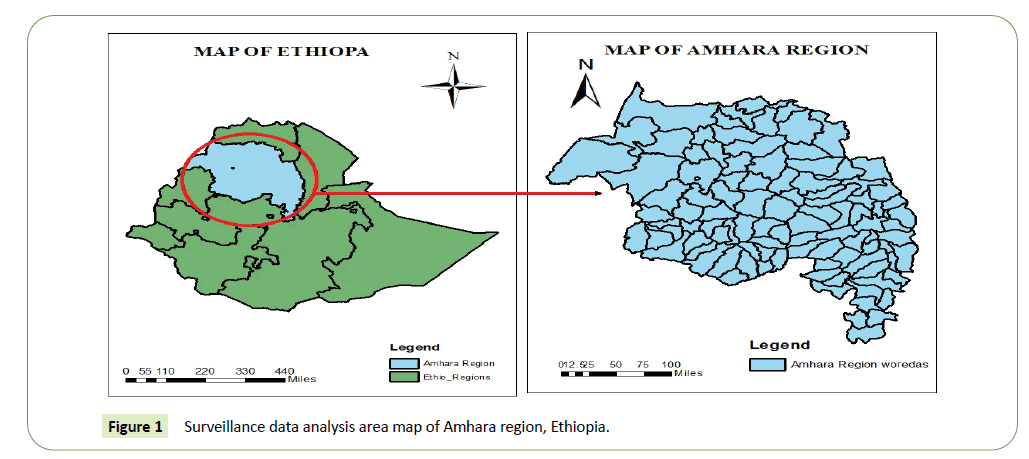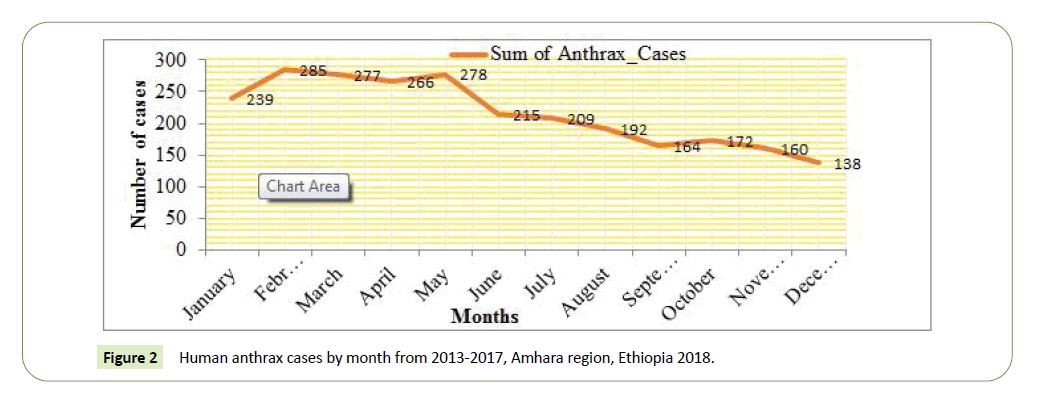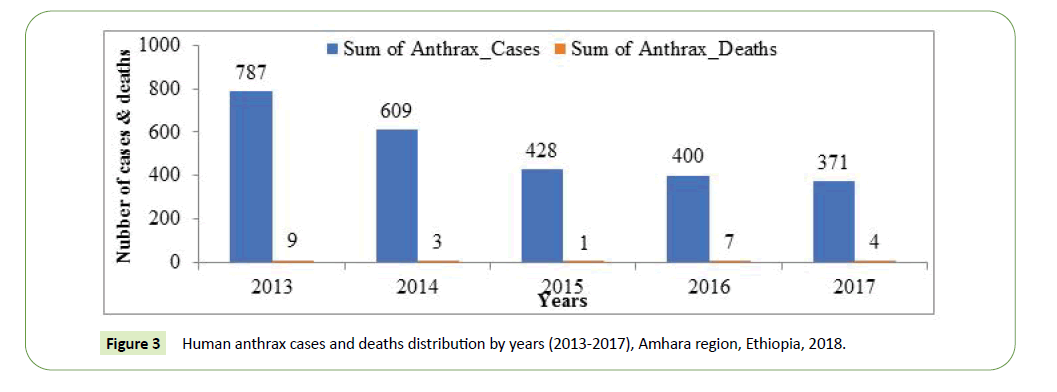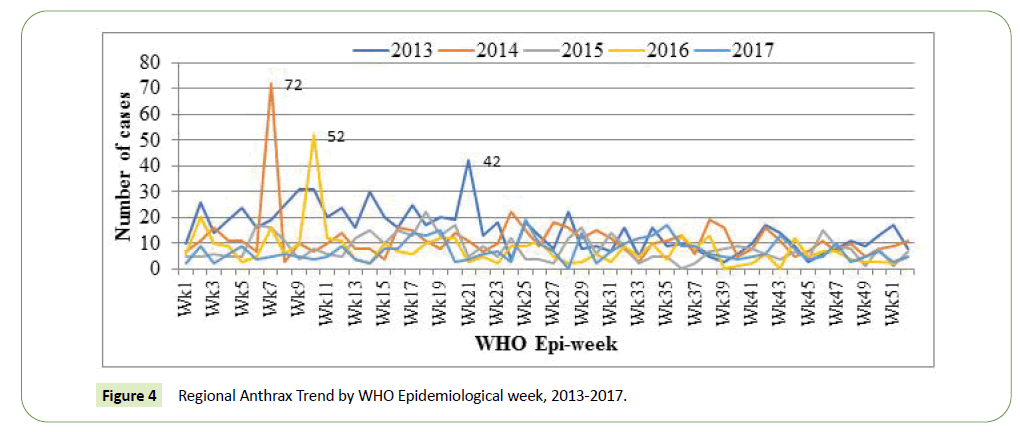Human Anthrax in Amhara Region, Ethiopia: A Retrospective Record Review 2013-2017
Yosef Gebreegziabher, Kinfe Haile and Zewdu Assefa
Yosef Gebreegziabher1*, Kinfe Haile2 and Zewdu Assefa3
1Ethiopian Field Epidemiology and Laboratory Training Program, Ethiopia
2Department of Public Health, St. Paul’s Hospital Millennium Medical College, Ethiopia
3Ethiopian Public Health Institute, Ethiopia
- *Corresponding Author:
- Yosef Gebreegziabher
Ethiopian Field Epidemiology and Laboratory Training Program, Ethiopia
E-mail: tabula.nassa@gmail.com
Received Date: October 19, 2020; Accepted Date: November 09, 2020; Published Date: November 16, 2020
Citation: Gebreegziabher Y, Haile K, Assefa Z (2020) Human Anthrax in Amhara Region, Ethiopia:A Retrospective Record Review 2013-2017. Med Clin Rev. Vol. 6 No. 6: 109.
DOI: 10.36648/2471-299X.6.6.109
Abstract
Yosef Gebreegziabher1*, Kinfe Haile2 and Zewdu Assefa3
1Ethiopian Field Epidemiology and Laboratory Training Program, Ethiopia
2Department of Public Health, St. Paul’s Hospital Millennium Medical College, Ethiopia
3Ethiopian Public Health Institute, Ethiopia
- *Corresponding Author:
- Yosef Gebreegziabher
Ethiopian Field Epidemiology and Laboratory Training Program, Ethiopia
E-mail: tabula.nassa@gmail.com
Received Date: October 19, 2020; Accepted Date: November 09, 2020; Published Date: November 16, 2020
Citation: Gebreegziabher Y, Haile K, Assefa Z (2020) Human Anthrax in Amhara Region, Ethiopia:A Retrospective Record Review 2013-2017. Med Clin Rev. Vol. 6 No. 6: 109.
DOI: 10.36648/2471-299X.6.6.109
Keywords
Amhara region; Anthrax; Ethiopia; Human; Surveillance
Introduction
Anthrax is an infectious, bacterial zoonotic disease of warmblooded animals including human beings. This disease is caused by a spore-forming, aerobic, gram-positive, rod shaped and nonmotile bacterium (Bacillus Anthracis) [1].
When a spore enters a mammal host, the internal environment of the host-rich in water, sugars and amino acids-induces that spore to germinate into a vegetative cell that leads to disease [2]. Infectious anthrax spores are found naturally in soil and commonly affect domestic and wild animals around the world [3]. An animal dying of anthrax produces enormous quantities of the bacterium in its tissues. If the carcass is opened or when exposed to open air of the hemorrhagic secretions or excretions, the vegetative bacilli convert to resistant spores which contaminate the soil, grass, and local water sources. Animals that graze in spore contaminated areas can become infected, resulting in a further cycle of infection, death, and release of spores to a new location. Wild carnivores and scavenger birds also contribute to the spread of spores by feasting on contaminated carcasses [4].
Human cases usually develop acutely after exposure to infected animals and their tissues. The human cases are significantly associated with the animal disease. In most countries, human anthrax occurs infrequently and sporadically, mainly as an occupational hazard among veterinarians, agricultural workers, and workers who process hides, hair, wool and bone products. Humans may exhibit three types of anthrax: cutaneous, gastrointestinal and inhalational. Cutaneous anthrax is acquired when a spore enters the skin through a cut or an abrasion; thus, anthrax scars are generally seen on exposed regions of the body, mostly on the face, neck, hands and wrists [5,6]. Cutaneous anthrax accounts for more than 95% of natural infections, and is rarely fatal if treated with antibiotics. The gastrointestinal form is less common but more serious, and can occur in outbreaks associated with eating contaminated food, primarily meat from an animal that died of the disease. Pulmonary (inhalational) anthrax, which is the most serious form and has a very high case fatality rate even when treated, occurs from breathing in airborne anthrax spores. Natural cases of inhalational anthrax are rare. The incubation period in humans is usually 1 to 7 days, but varies with the form of the disease [5].
Anthrax is distributed worldwide. Although in developing countries the disease is endemic, most common and human case rates for anthrax are highest; countries that do not have veterinary public health programs that routinely vaccinate animals against anthrax, in agricultural regions of several sub- Saharan African countries, Central and South America, Middle East, central and southwestern Asia, southern and Eastern Europe, and the Caribbean. Where the disease uncommon in animals, but extremely rare in humans[1,6,7].
In Ethiopia, animal anthrax is an endemic disease that occurs in May and June every year (‘anthrax season’) in several farming localities of the country, causing disease both in humans and livestock. Although suspected cases of anthrax are reported from several districts, few of these are officially confirmed [8]. Previous studies indicate that the disease is well recognized by rural communities but little is known about its prevalence, epidemiology and public health significance [9].
According to Federal Democratic Republic of Ethiopia Ministry of Health surveillance data, in the Ethiopian fiscal year 2005 (Gregorian year 2012/2013), there were a total of 1,233 suspected human anthrax cases and 15 deaths with a Case Fatality Rate (CFR) of 1.2% recorded in the country. Cases were reported from four regions (Amhara, Tigray, SNNPR and Oromiya). The most cases and deaths were reported from Amhara region [929 (75%) cases and 8 (53%) deaths] [10].
Anthrax is a serious zoonotic disease that can affect most mammals and several species of birds, as well as humans [11]. Anthrax is one of the twenty priority diseases under the Ethiopian Public Health Emergency Management system that should be reported immediately when encountered. Ongoing analysis of surveillance data is important for detecting outbreaks and unexpected increases or decreases in disease occurrence, monitoring disease trends, and evaluating the effectiveness of disease control programs and policies. This information is also needed to determine the most appropriate and efficient allocation of public health resources and personnel [12].
Continuous surveillance and data analysis are also important to evaluate the trends of anthrax related to intervention measures in controlling and preventing of the disease. In Amhara region anthrax is endemic, so it is an important public health issue and there is an apparent need for accurate information through a strong surveillance system to warrant evidence-based action. Therefore, analyzing anthrax data can be used to assess the trend of anthrax in the region and determine the distribution of cases. This helps to identify areas to which anthrax is hyper endemic, and figure out the completeness of the reporting system to engage in corrective actions. Previous published information was not obtained which shows the status of human anthrax in Amhara region. So, it was decisive to see the recent status of the disease in the region; the main propose of this analysis was to assess the five years (2013-2017) anthrax trend in the region in order to get valuable inputs and recommend evidence-based interventions for the future.
The objective of this data analysis was to analyze and describe magnitude, trend, timeliness rate, completeness rate, and limitations of anthrax surveillance data in Amhara region from 2013-2017.
Methods
Study area, population and period
The analysis was conducted in Amhara region, which is one of the nine regional states of Ethiopia, located in North Western part of the country. Bahir Dar is capital city of the region. The region has an estimated land area of about 154,708.96 square kilometers. Amhara region is bordered by the state of Sudan to the West and Northwest, and in other directions by other regions of Ethiopia: Tigray
to the North, Afar
to the East, Benishangul-Gumuz
to the West and Southwest, and Oromia
to the South. The region is administratively divided into 12 zones, and 140 Woredas. The recent population size predicted to be 21,134,988 of which male 10,585,995 and female 10,548,993 in 2017 [13]. Five-year (2013-2017) anthrax data were analyzed from June-August 2018 (Figure 1).
Source of data
Amhara region five years (2013-2017) human anthrax surveillance secondary data was obtained from the data base of public health emergency management department of Ethiopian Public Health Institute (PHEM/EPHI); from which we used to review human anthrax. Human population was obtained from Ethiopian Central Statistics Agency, 2007 census projection.
Study design and data analysis
We conducted a descriptive evaluation of Amhara region anthrax surveillance data during 2013-2017. The trend and distributions of anthrax cases during the time period were calculated. The data was analyzed using Microsoft office Excel 2007, and the finding was presented by using tables and graphs.
Case definitions
According to Ethiopian Public Health Emergency Management Guideline, a suspected case of anthrax was any person with acute onset of disease characterized by several clinical forms which include [14]:
Suspected: Any person with acute onset characterized by several clinical forms which are:
1) Localized form
Cutaneous: skin lesion evolving over 1 to 6 days from a popular through a vesicular stage, to a depressed black Escher invariably accompanied by edema that may be mild to extensive.
2) Systemic forms
Gastro-intestinal: Abdominal distress characterized by nausea, vomiting, anorexia and followed by fever.
Pulmonary (inhalation): brief prodrome resembling acute viral respiratory illness, followed by rapid onset of hypoxia, dyspnea and high temperature, with x-ray evidence of mediastinal widening.
Meningeal: acute onset of high fever possibly with convulsions, loss of consciousness, Meningeal signs and symptoms; commonly noted in all systemic infections and has an epidemiological link to confirmed or suspected animal cases or contaminated animal products.
Ethical consideration
First permission approval was obtained from public health emergency management/EPHI then after five years regional Anthrax data accessed to carry out this analysis.
Data dissemination
Findings of the data were reported to St. Paul Hospital Millennium Medical College School of Public Health EFELTP, shared to EFELTP Resident advisor and coordinator of St. Paul Hospital Millennium Medical College and EPHI.
Results
Magnitude of anthrax in the region
During the last five years (2013-2017), a total of 2,595 human anthrax cases and 24 deaths were documented in Amhara region.
The trend of human anthrax cases by time
Cases by year: Of the total cases reported, most of cases 787(30.4%) and deaths 9(37.5%) occurred in 2013. The fewest cases371(14.3%) occurred in 2017 and the fewest deaths 1(4.2%) occurred in 2015. Regionally, there was a continuous substantial decrease in the number of human anthrax cases, but there was fluctuation up on the number of deaths over the time period 2013-2017 (Figure 2).
Cases by month: As we seen cases by month below in Figure 3, the highest numbers of human anthrax cases were reported in the months of February (285) and May (278), sum of the two months result account for 21.7% of the total regional cases.A total of 1,067(41.1%) cases were reported in the first quarter (from January-April), 894(34.5%) in the second quarter (from May- August) and 634(24.4%) in the third quarter (from September- December). The case report did not have regular trend but from February to May it showed highest cases 1,106(42.6%) as shown in the graph below (Figure 2). The number of anthrax cases reported ranged from 138-285 cases for different months in the last five years. In particular, the monthly trend showed an increase number of anthrax cases in month February-May of the fiscal year reaching the high in February, whereas the anthrax cases decreased from month May-December reaching the lowest in December.
Cases by WHO epidemiological week: As shown in (Figure 4) below the largest number of cases72, 52 and 42 were reported in week 7 0f 2014, week 10 of 2016 and week 21 of 2013 respectively. Relatively the trend is showing highest number of cases until week 23 of 2013. The trend of anthrax based on WHO Epidemiological weeks was continues and no interruption was seen in the region from 2013 up to 2017; it indicates that anthrax was one of the burdens of the region for the last five years.
The trend of human Anthrax Cases by Place: The number of human anthrax cases in different zones and special woredas, range from 0 to 1,520. Zero (no) cases were reported from Argoba Special Woreda and Bahir Dar Special Town. Nearly all 2,389(92.1%) cases were reported from Wag Himra, North Gondar, South Gonder, and South Wollo zones. Of which Wag Himra reported 1,520(58.6%), North Gondar 524(20.2%), South Gonder 186(7.2%) and South Wollo 159(6.1%) cases, while the least number of cases were reported from Dese Town 2(0.1%) followed by Awi 4(0.2%). During 2013-2017, human anthrax the highest Case Fatality Rate (CFR %) was seen in Oromia (28.6%) followed by South Wollo (5.0%) (Table 1).
Table 1 Anthrax Cases, deaths and CFR by Zones and special woredas of Amhara region, 2013-2017.
| Zones/special woredas | Cases (%) | Deaths (%) | CFR (%) |
|---|---|---|---|
| Argoba Special Woreda | 0(0.0%) | 0(0.0%) | 0.00% |
| Bahir Dar Liyu Town | 0(0.0%) | 0(0.0%) | 0.00% |
| Dese Town | 2(0.1%) | 0(0.0%) | 0.00% |
| Awi | 4(0.2%) | 0(0.0%) | 0.00% |
| Oromiya | 7(0.3%) | 2(0.3%) | 28.60% |
| West Gojjam | 17(0.7%) | 0(0.7%) | 0.00% |
| North Wollo | 27(1.0%) | 0(1.0%) | 0.00% |
| Gonder Town | 37(1.4%) | 0(1.4%) | 0.00% |
| North Shewa | 47(1.8%) | 0(1.8%) | 0.00% |
| East Gojjam | 65(2.5%) | 2(2.5%) | 3.10% |
| South Wollo | 159(6.1%) | 8(6.1%) | 5.00% |
| South Gonder | 186(7.2%) | 0(7.2%) | 0.00% |
| North Gondar | 524(20.2%) | 6(20.2%) | 1.20% |
| Wag Himra | 1,520(58.6%) | 6(58.6%) | 0.40% |
| Grand Total | 2,595(100.0%) | 24(100.0%) | 1.60% |
In 2013 Wag-himra zone had highest number of cases, which were 458(17.6%) followed by North Gonder zone 153(5.9 %). In all years, Wag-himra zone had greater number of cases than other Zones/special woredas and also followed by North Gonder zone. Out of the total zones and special woredas of the region only 7 of them were reported the anthrax cases continuously without zero (no) report the whole of five years (Table 2).
Table 2 All human anthrax cases by year and Zones/special woredas of Amhara region, 2013-2017.
| Zones/special woredas | Years | Grand Total | ||||
|---|---|---|---|---|---|---|
| 2013 | 2014 | 2015 | 2016 | 2017 | ||
| Argoba Special Woreda | 0 | 0 | 0 | 0 | 0 | 0 |
| Awi | 0 | 2 | 0 | 2 | 0 | 4 |
| Bahir Dar special Town | 0 | 0 | 0 | 0 | 0 | 0 |
| Desse Town | 0 | 1 | 0 | 0 | 1 | 2 |
| East Gojjam | 29 | 14 | 4 | 3 | 15 | 65 |
| Gonder Town | 17 | 6 | 3 | 5 | 6 | 37 |
| North Gondar | 153 | 102 | 81 | 132 | 56 | 524 |
| North Shewa | 34 | 2 | 1 | 4 | 6 | 47 |
| North Wollo | 0 | 9 | 6 | 11 | 1 | 27 |
| Oromiya | 1 | 6 | 0 | 0 | 0 | 7 |
| South Gonder | 53 | 57 | 29 | 34 | 13 | 186 |
| South Wollo | 42 | 92 | 6 | 8 | 11 | 159 |
| Wag-Himra | 458 | 316 | 297 | 187 | 262 | 1520 |
| West Gojjam | 0 | 2 | 1 | 14 | 0 | 17 |
| Grand Total | 787 | 609 | 428 | 400 | 371 | 2595 |
Discussion
The aim of this data analysis was to give a description of human anthrax trend in Amhara regional state. This analysis shows during the last five years (2013-2017) a total of 2,595 human anthrax cases and 24 deaths were documented in region, which shows that the number of human anthrax cases and deaths reported were increased by 23.2% and 60% respectively than the previous national study [15]. The fatality of the case between 2013 and 2017 in the region was higher (Case fatality rate 1.6%) compared to previous national study (Case fatality rate 0.7%) [15], this might be due to the improvement of surveillance and reporting system of the region.
The highest number of cases 787(30.4%) and the lowest number of cases 371(14.3%) were reported in 2013 and 2017 respectively. Results of retrospective data analysis have indicated that there was an annual decreasing record of anthrax cases in the region during the last five years (2013-2017). This might be due to increased awareness of the community about the transmission of the disease, improved health education in rural areas and increased vaccination coverage of animals against anthrax.
The highest numbers of human anthrax cases were reported in the month of February (285) and May (278) cases, both of which account 21.7% of the total cases. A total of 1,106(42.6%) cases were reported from February to May. This is dry season, during this time the grass is short and animals are, forced to graze very close to the ground. This increases chances of animals picking up anthrax spores in areas whose soils and pastures are contaminated with the spores [16]. Therefore, case of anthrax in animals is very common during this time and as a result increasing risk of human anthrax exposure.

Open Access Journals
- Aquaculture & Veterinary Science
- Chemistry & Chemical Sciences
- Clinical Sciences
- Engineering
- General Science
- Genetics & Molecular Biology
- Health Care & Nursing
- Immunology & Microbiology
- Materials Science
- Mathematics & Physics
- Medical Sciences
- Neurology & Psychiatry
- Oncology & Cancer Science
- Pharmaceutical Sciences




